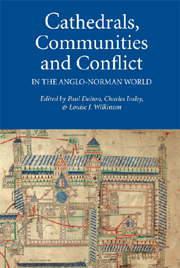Book contents
- Frontmatter
- Contents
- List of Illustrations
- List of Contributors
- Preface
- List of Abbreviations
- Introduction
- 1 The Dangers of Invention: The Sack of Canterbury, 1011, and the ‘theft’ of Dunstan's Relics
- 2 Remembering Communities Past: Exeter Cathedral in the Eleventh Century
- 3 Communities, Conflict and Episcopal Policy in the Diocese of Lichfield, 1050–1150
- 4 The Acta archiepiscoporum Rotomagensium and Urban Ecclesiastical Rivalry in Eleventh-Century Rouen
- 5 Cathedrals and the Cult of Saints in Eleventh-and twelfth-Century Wales
- 6 A Bishop and His Conflicts: Philip of Bayeux (1142–63)
- 7 Ecclesiastical Responses to War in king Stephen's Reign: The Communities of Selby Abbey, Pontefract Priory and York Cathedral
- 8 Secular Cathedrals and the Anglo-Norman Aristocracy
- 9 The Lives of Thomas Becket and the Church of Canterbury
- 10 Caught in the Cross-Fire: Patronage and Institutional Politics in Late twelfth-Century Canterbury
- 11 Crown, Cathedral and Conflict: King John and Canterbury
- 12 The English Monasteries and their French Possessions
- Index of People and Places
- Other Volumes in Studies in the History of Medieval Religion
3 - Communities, Conflict and Episcopal Policy in the Diocese of Lichfield, 1050–1150
Published online by Cambridge University Press: 12 September 2012
- Frontmatter
- Contents
- List of Illustrations
- List of Contributors
- Preface
- List of Abbreviations
- Introduction
- 1 The Dangers of Invention: The Sack of Canterbury, 1011, and the ‘theft’ of Dunstan's Relics
- 2 Remembering Communities Past: Exeter Cathedral in the Eleventh Century
- 3 Communities, Conflict and Episcopal Policy in the Diocese of Lichfield, 1050–1150
- 4 The Acta archiepiscoporum Rotomagensium and Urban Ecclesiastical Rivalry in Eleventh-Century Rouen
- 5 Cathedrals and the Cult of Saints in Eleventh-and twelfth-Century Wales
- 6 A Bishop and His Conflicts: Philip of Bayeux (1142–63)
- 7 Ecclesiastical Responses to War in king Stephen's Reign: The Communities of Selby Abbey, Pontefract Priory and York Cathedral
- 8 Secular Cathedrals and the Anglo-Norman Aristocracy
- 9 The Lives of Thomas Becket and the Church of Canterbury
- 10 Caught in the Cross-Fire: Patronage and Institutional Politics in Late twelfth-Century Canterbury
- 11 Crown, Cathedral and Conflict: King John and Canterbury
- 12 The English Monasteries and their French Possessions
- Index of People and Places
- Other Volumes in Studies in the History of Medieval Religion
Summary
This paper takes a fresh look at an episode in Anglo-Norman church history: the removal of the north-west Mercian bishopric from Lichfield to Chester in the time of William I, followed within a generation by its further removal from Chester to Coventry. The episcopal shuffle of Bishops Peter and Robert de Limesey was not the only relocation of an English cathedral in the late eleventh century, nor even the only double removal, but the continuing links of the communities at Lichfield, Chester, and Coventry with their bishop were unparalleled, leading the later twelfth-century Norman historian Robert of Torigni to express surprise that the bishopric should still in his own day have three seats or sees (sedes). The case of Lichfield merits re-evaluation not because there is new evidence, but because rethinking it in the context of the communities of Lichfield, Chester, and Coventry gives new perspectives on their multiple inter actions and on episcopal policy. the communities involved were not limited to the chapters of the cathedral, St John's church in Chester, and the abbey.
Lichfield was one of the poorest dioceses and its first two Norman bishops were unimportant in politics. Three sorts of explanation have been offered for the move from Lichfield to Chester, variously invoking what might be called ‘ideological’ and ‘strategic’ factors, but there are problems with each and none is especially compelling. first is the assertion that Lichfield was only a village, and that by the mid eleventh century villages were no longer acceptable as diocesan seats.
- Type
- Chapter
- Information
- Publisher: Boydell & BrewerPrint publication year: 2011

